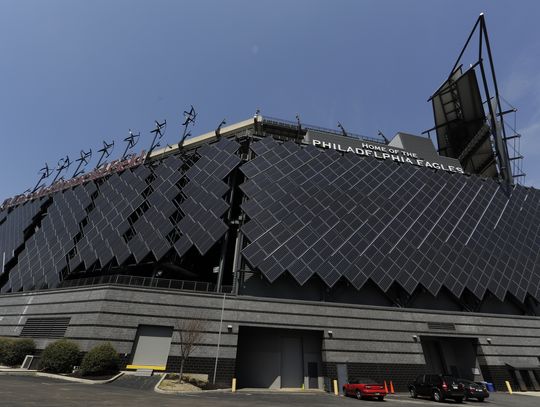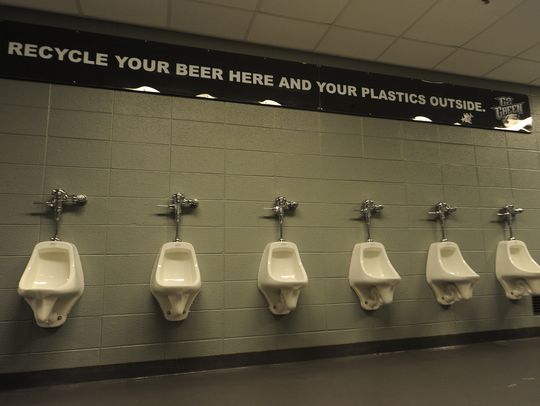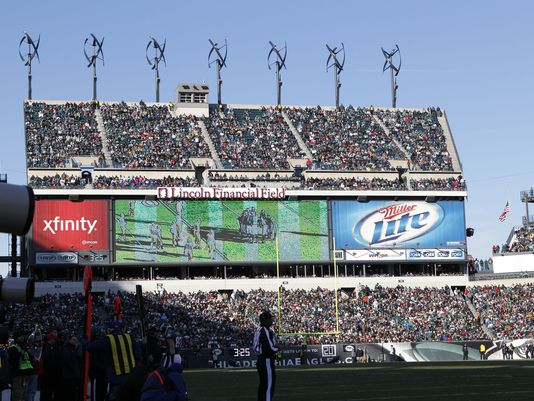Go Green! Sports stadiums save energy
Sport stadiums around the country strive to go environmentally green.
You could view a National Football League stadium as a hulk of concrete and steel, where video boards and bright lights eat up electricity, refrigeration is needed to keep the beer cold, halftimes are flush-fests and cars idle before and after games.
On this celebration of Earth Day, hold the carbon-emitting negativity.
Since January, 11,000 solar panels and 14 wind turbines have been generating power at Lincoln Financial Field, home of the Philadelphia Eagles. The team's 10-year-old "Go Green" campaign also includes reduced water and electrical use, recycled paper products for all tissues, conversion of cooking oil into biodiesel fuel, a digital version of the cheerleaders calendar to spare trees and compostable packaging for the hot dogs and Philly cheese steaks.
Signs in the men's rooms at Lincoln Financial: "Recycle your beer here and your plastics outside." Among other signs at the stadium: "The only water we waste is sweat."
It's environmental stewardship with a touch of salesmanship.
"We try not to preach, but we definitely want to promote and encourage," says Don Smolenski, president of the Eagles.
GREEN TECH: NASCAR's sound and fumes can mask green initiatives[1]
The Eagles are not alone. CenturyLink Field, home of the Seattle Seahawks (NFL) and Seattle Sounders (Major League Soccer), has 3,750 solar panels (2.5 acres) on the roof of an adjacent events center. Target Field, home of baseball's Minnesota Twins, collects rainwater for use in washing down the seating area. The Miami Heat (National Basketball Association) play at AmericanAirlines Arena. Its reflective roof and underground parking are designed to beat the heat and cut energy costs.
The stadium under construction for the NFL's San Francisco 49ers in Santa Clara, Calif., will have solar panels and a green roof of soil and plant life covering its tower of luxury suites to provide insulation.
Auto racing burns fuel and tires. But NASCAR has a program — NASCAR Green — that includes tire recycling and, since 2011, use of fuel it says produces less carbon emissions. NASCAR says it will plant 8,000 trees this year to offset carbon emissions. Pocono Raceway in Pennsylvania has about 40,000 solar panels.
You may not buy the notion of athletes as role models. But the green movement is quick to identify sports and its venues as just that.
"It's one of the most culturally influential sectors in the country, in the world. The most-watched TV shows are sporting events. Sports matters, and it's a gigantic business," says Allen Hershkowitz, senior scientist at the non-profit Natural Resources Defense Council (NRDC).
"I work with the St. Louis Cardinals (baseball) at Busch Stadium. They reduced their energy use in the last three years by 24%. … That gets noticed. … The Seattle Mariners (baseball) save over a $1 million a year in reducing their energy costs and their waste costs. That's certainly a good role model for other businesses to emulate."
In recent years, Hershkowitz's group has advised the NFL, Major League Baseball, the National Basketball Association, the National Hockey League and Major League Soccer.
The NRDC, whose involvement in sports was spearheaded by actor Robert Redford, issued a report last year titled "Game Changer … How the sports industry is saving the environment."
Among the findings:
• Of the 126 pro teams in the five major sports, 38 use renewable energy for at least some of their needs and 68 have energy-efficiency programs.
• Eighteen venues have installed solar panels.
• "Virtually all" have or are developing recycling and composting programs.
• Under a rating system known as LEED, 15 pro venues have been certified as "green" buildings. LEED (Leadership in Energy and Environmental Design) is administered by the U.S. Green Building Council, a building industry non-profit. The 49ers' new stadium is targeted to open in 2014 with LEED certification.
GREEN TECH: Clean technology firms struggle for funding[2]
POWERS: Obama's point man on greening the government[3]
While most baseball games are at night (as well as many college football games, a growing number of NASCAR races and even more NFL contests), Hershkowitz isn't calling for baseball to halt night games to save electricity.
"I love night games. The issue is not the lights. The issue is, where is the energy coming from?" he says. "... If the power is coming from wind or from hydro or from solar, that's good."
Pro sports franchises aren't non-profits. Is there financial incentive for them to go green?
"Reducing your energy costs, reducing your water costs, reducing your waste costs is a money saver as it is an environmental winner," says Hershkowitz.
STADIUMS AND SOLAR
NRG Energy, based in Princeton, N.J., has partnered in solar projects at NFL stadiums with the Eagles, Washington Redskins, New England Patriots and New York Jets/New York Giants (both at MetLife Stadium). NRG also has partnered with the 49ers.
David Crane, CEO of NRG, says the "spread out" nature of stadiums suits solar, and installing the panels on roofs over parking lots provides extra benefits of shade and shelter for fans.
From NRG's point of view, Crane says, one appeal of getting involved with the NFL is its success and visibility. "If the NFL owners are making decisions to go with clean-energy choices, then maybe other businesses should and also even the fans," says Crane.

Solar panels and wind turbines on Lincoln Financial Field, home of the NFL's Philadelphia Eagles.(Photo: Eileen Blass, USA TODAY)
NRG owns the panels and wind turbines at Lincoln Financial and invested in their installation. The Eagles signed a 20-year contract to buy power from NRG.
"The way that all the NFL deals basically work is that we install, operate and own the solar panels, and they agree to buy the power … for a fixed period of time. … It's at least 10 and sometimes up to 20 years," says Crane.
Smolenski says the project is expected to generate about 30% of the stadium's annual usage of power.
"There are days … where there's no activity at the stadium and the sun is shining, there is a breeze. We'll actually be putting power back into the grid. And obviously on game days our power draw is bigger than what the system can produce, but that's OK," he says.
Smolenski says the Eagles offset the rest of their annual power usage by purchasing what are called renewable energy credits, which support renewable energy development. He says an advantage to the deal with NRG is that it provides cost stability.
"That's significant," says Smolenski. "There were times when the cost of power can spike. … We're no longer subject to those fluctuations."
AN INSPIRATION
Eagles owner Jeff Lurie and his former wife, Christina Weiss Lurie, launched "Go Green" in 2003. Weiss Lurie says they have been inspired by Al Gore's environmental film, An Inconvenient Truth.
"As a football team, we have a unique platform, where we can really make a difference," says Weiss Lurie. "... We really need to all care about our planet, and you can do it in small steps, or you can do it in larger ways."
"Midnight green" is the basic team color of the Eagles. "Go Green" was a natural. On their website, the Eagles have a "Go Green playbook." It urges fans to recycle, conserve and buy green. It suggests they recycle old tires and use short-run cycles on their dishwashers and clothes washers.
"We're at 99% diversion (from the landfill). We'll soon be at 100%," says Smolenski.
Smolenski describes the overall green program as "cost neutral" at this stage. That's an improvement over the early years.
"Recycled napkins were more expensive," says Smolenski. "… That's not the case anymore. … With the leverage of our purchasing power and (concessionaire) Aramark's purchasing power, we were able to get the same price."
At FedExField, home of the Redskins, there is a 30-foot-high sculpture of a football player made from solar panels. It's called "Solar Man." More than 800 solar panels cover a nearby parking lot.
There is a ring of solar panels atop MefLife Stadium, home of the Giants and Jets. The panels are illuminated in green when the Jets are playing and blue when it's the Giants.
"Obviously, that's not the cheapest way to generate solar power … to lift highly specialized solar panels, which are LED backlit, to the top of the stadium," says Crane of NRG. "… But the whole package is compelling to them as a business proposition."
At Lincoln Financial, there are about 8,100 panels over a parking lot. There are others on the roof and facade of the stadium and over sidewalks. There are seven turbines (the curved, egg-beater type) above the stands in each endzone.
Weiss Lurie says the turbines generate only about 1% of the power in the new system. But fans in the seats and motorists driving by on Interstate 95 can see the turbines.
"I think it's important sometimes to have a visual symbol," says Weiss Lurie.
Says Smolenski, "They are awesome. I can see them from my window. ... I look out my window every day and see them spinning."

A humorous recycling reminder in a men's restroom at Lincoln Financial Field, home of the NFL's Philadelphia Eagles.(Photo: Eileen Blass, USA TODAY)
References
- ^ http://www.usatoday.com/story/money/business/2013/04/21/green-tracks-fuel-tires-recycle-sonoma-pocono-sunoco/2101689/ (www.usatoday.com)
- ^ http://www.usatoday.com/story/money/business/2013/03/25/financing-green-tech-companies/1919633/ (www.usatoday.com)
- ^ http://www.usatoday.com/story/money/business/2013/04/01/federal-environmental-executive/1990623/ (www.usatoday.com)










